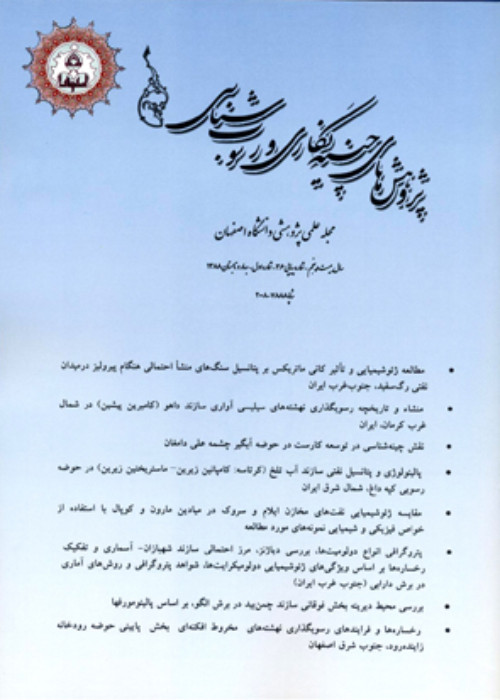Petrography and isotope-geochemistry of the Bayandor Formation dolomites at the type section, south-west of the Zanjan
Author(s):
Article Type:
Research/Original Article (دارای رتبه معتبر)
Abstract:
The Late Precambrian Bayandor Formation has a thickness of 402 m and consists of shale and sandstone with dolomite interlayers (with a thickness of about 2 to 8 m) in the type section of the south-west of Zanjan. Based on fieldwork studies lithofacies of the Bayandor Formation belong to a coastal plain and shallow marine environments have been considered for the Bayndor Formation. Distribution and expansion of the dolomites in this formation are parallel with the sedimentary layers and has considerable lateral extension in the field. Carbonate sequences of these deposits have all been thoroughly dolomitized, due to the effects of dolomitic fluids and it is difficult to recognize the original depositional textures. In these dolomites, the abundant chert nodules and blue-green algaes (stromatolites) clearly observed along with the sedimentary bedding. During the petrographic study, the dolomites of Bayandor Formation based on fabric and crystal size divided into the three groups including fine, medium and medium to coarse crystalline dolomites. In these samples the contents of 13C isotope are varies between -1.63 to - 2.02 PDB‰ and the contents of 18O isotope are varies between -5.94 and -8.15 PDB‰. These values are almost similar to the carbon and oxygen values of the Late Precambrian seawater. Based on fieldwork, petrography and geochemical results and also by determining of temperature formation (around 38°C), the source of magnesium for fine and medium crystalline dolomites are seawater, and likely the conditions for the formation of these dolomites are seepage-reflux dolomitization model during the shallow burial environments. With increasing temperature during the burial process, medium to coarse crystalline dolomites also formed from the previous ones. The oxygen isotope data for the medium to coarse crystalline dolomite does not show a significant difference with the fine and medium crystalline dolomites. This can show that these types of dolomites also formed during the shallow burial conditions and perhaps from the recrystallization process of the fine crystalline dolomites. These results in addition to a shallow marine sedimentary environment of the Bayndor Formation show that the formation of these dolomites might be because of seepage-reflux model by seawater during the shallow burial.
Keywords:
Language:
Persian
Published:
Stratigraphy and Sedimentology Researches, Volume:35 Issue: 1, 2019
Pages:
37 to 52
magiran.com/p2006609
دانلود و مطالعه متن این مقاله با یکی از روشهای زیر امکان پذیر است:
اشتراک شخصی
با عضویت و پرداخت آنلاین حق اشتراک یکساله به مبلغ 1,390,000ريال میتوانید 70 عنوان مطلب دانلود کنید!
اشتراک سازمانی
به کتابخانه دانشگاه یا محل کار خود پیشنهاد کنید تا اشتراک سازمانی این پایگاه را برای دسترسی نامحدود همه کاربران به متن مطالب تهیه نمایند!
توجه!
- حق عضویت دریافتی صرف حمایت از نشریات عضو و نگهداری، تکمیل و توسعه مگیران میشود.
- پرداخت حق اشتراک و دانلود مقالات اجازه بازنشر آن در سایر رسانههای چاپی و دیجیتال را به کاربر نمیدهد.
In order to view content subscription is required
Personal subscription
Subscribe magiran.com for 70 € euros via PayPal and download 70 articles during a year.
Organization subscription
Please contact us to subscribe your university or library for unlimited access!


